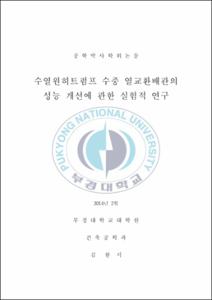수열원히트펌프 수중 열교환배관의 성능 개선에 관한 실험적 연구
- Alternative Title
- An Experimental Study on Improving Heat Transfer of Piping Used for Surface Water Heat Exchanger in Heat Pump System
- Abstract
- Abstract
Surface water source heat pump system(SWSHPS) is an energy efficient heat recovery system compared to air source heat pump(ASHP) used in the building HVAC system. SWSHPS can be used for HVAC system when the building is located near at pond, sea, or river.
The heat transfer rate(U value) of surface water heat exchanger(SWHE) impacts on coefficient of performance(COP) in SWHPS. Therefore, the improvement of U value in SWHE became a significant issue in HVAC area. In general, high density polyethylene(HDPE, thermal conductivity is 0.4 W/mK) tube has been successfully utilized in surface water source heat pump system as a surface water heat exchange. However, U value of HDPE tube is found to be low, making the application of HDPE tube less energy efficient.
This study aims to improve the U value of HDPE pipe in SWHE system through 1) make fin shape with the same HDPE material, 2) make the fin shape using round copper(whose thermal conductivity is 400 W/mK) wire, and 3) make the fin shape using square copper wire. Thus, the experimental study was performed on evaluating U values of the three suggested HDPE pipes that are immersed in the water chamber.
To produce fin shape with the same HDPE material, the external surface of conventional 32A tube was grooved, and as a result the cross sectional area of the grooved HDPE pipe was reduced. The final shape of grooved HDPE tube was similar to that of fin(h 1.5mm, t 1.5mm, p 5.0mm). In order to verify the performance of grooved HDPE tube, the U values of grooved and conventional tube were compared experimentally. According to the results, U value of grooved tube (32A HDPE, length 24.54m) showed approximately 21.5% increase with natural convection and 23.5% with forced convection system than U values obtained from conventional tube. The reason for such increase in U value was found to be the reduction in cross sectional area of the polyethylene tube.
A new concept of SWHE was developed. It is to wind φ2.25 spiral copper coil with 4mm pitch to the grooved HDPE tube 16A(length 18.2m). This tube has two advantages; first one is the same durability as existing HDPE tube, and the second one is higher conductivity that was introduced by winding the copper wire. The comparison experiments were conducted on two samples in the same bath condition; one with reference sample(only with HDPE pipe) and the other with the winded copper coil. The experimental results presented that U value of winded tube was 15.2% higher than the conventional HDPE tube.
The HDPE tube was also wound using the fin of very highly conductive square copper wire(h 3.5mm, t 2.5mm, p 7.0mm). In order to verify the U value of HDPE tube with square copper wire (32A HDPE, length 24.54m), the U values of conventional tube were compared experimentally. According to the results, U value of HDPE tube with square copper wire showed 19.1% increase with natural convection and 17.5% increase with forced convection system than U values obtained from conventional tube at hot fluid velocity range; 0.6~0.8 m/s. The reason for such increase in U value was found to be the fin effect.
According to the experimental results in this work, in the underwater, the material which has low conductivity such as HDPE pipe do not bring the fin effect. In contrast, the material which has higher conductivity such as copper wire can make the fin effect to occur. Therefore, it was found that HDPE pipe wound by copper wire will definitely contribute to the energy saving in the HVAC system.
- Issued Date
- 2014
- Awarded Date
- 2014. 2
- Type
- Dissertation
- Publisher
- 부경대학교
- Alternative Author(s)
- Han-Ji Kim
- Affiliation
- 대학원
- Department
- 대학원 건축공학과
- Advisor
- 정근주
- Table Of Contents
- 1. 서 론 1
1.1 연구의 배경 1
1.2 연구의 목적 3
1.3 관련 연구 동향 5
1.4 연구의 방법 및 범위 8
2. 수열원히트펌프 및 배관 열관류 이론 11
2.1 히트펌프시스템 개요 11
2.2 수열원히트펌프시스템 및 수중 열교환배관 13
2.3 수중 열교환배관 열관류 방정식 16
2.4 배관의 열전도에 의한 열관류 방정식 19
2.5 대류에 의한 열관류 방정식 20
2.6 수중 열교환배관 열관류율 계산과정 26
3. 홈을 낸 HDPE배관의 열관류 성능 실험 28
3.1 개 요 28
3.2 홈을 낸 HDPE배관 샘플 제작 30
3.3 배관 열관류율 실험 장치 32
3.4 측정장비의 종류 및 사양 34
3.5 홈을 낸 HDPE배관의 열관류율 측정 35
3.6 홈을 낸 HDPE배관의 열관류율 분석 37
3.7 소 결 52
4. 원형 동선을 감은 HDPE배관의 열관류 성능 실험 54
4.1 개 요 54
4.2 원형 동선을 감은 HDPE배관 샘플 제작 55
4.3 배관 열관류율 실험 장치 57
4.4 원형 동선을 감은 HDPE배관의 열관류율 측정 60
4.5 원형 동선을 감은 HDPE배관의 열관류율 분석 62
4.6 소 결 64
5. 각형 동선을 감은 HDPE배관의 열관류 성능 실험 65
5.1 개 요 65
5.2 각형 동선을 감은 HDPE배관 샘플 제작 66
5.3 각형 동선을 감은 HDPE배관의 열관류율 측정 67
5.4 각형 동선을 감은 HDPE배관의 열관류율 분석 68
5.5 소 결 78
6. 결 론 79
약 어 82
참고문헌 84
감사의 글 87
- Degree
- Doctor
- Files in This Item:
-
-
Download
 수열원히트펌프 수중 열교환배관의 성능 개선에 관한 실험적 연구.pdf
기타 데이터 / 10.03 MB / Adobe PDF
수열원히트펌프 수중 열교환배관의 성능 개선에 관한 실험적 연구.pdf
기타 데이터 / 10.03 MB / Adobe PDF
-
Items in Repository are protected by copyright, with all rights reserved, unless otherwise indicated.